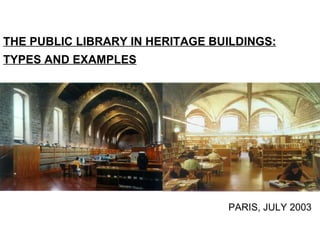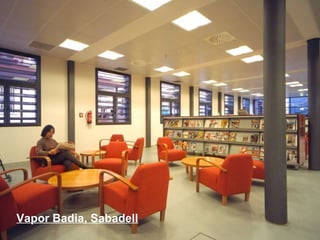IFLA Paris 2003 - Library Buildings Section
- 1. THE PUBLIC LIBRARY IN HERITAGE BUILDINGS: TYPES AND EXAMPLES PARIS, JULY 2003
- 2. Library Service of the Barcelona Provincial Council In the province of Barcelona, the public library service is a municipal service The Library Service does not manage libraries The Library Service gives suport to the local councils on the planning and creation of new libraries The Library Service offers centralised services to the libraries and facilitates their networking (for example: the union catalogue management) The Library Service offers library service in small towns (400-3.000 inhabitants), through 9 mobile libraries
- 3. Province of Barcelona Population over 4.6 million 311 municipalities The Library Network: 164 libraries and 9 mobile libraries
- 4. Library facilities: services offered by the Library Service Advice to local councils on planning and programming: Library model Map of needs for the territory Standards of facilities and basic services Operational programme Monitoring of projects with the architects responsible Monitoring of construction work Supervision of the final facility Subsequent assessment of how the facility works
- 5. Interventions by the Library Service on Heritage Buildings Interventions on 101 buildings since 1993 34 of these were in heritage buildings (33%) Diputaci├│ de Barcelona, Servei de Biblioteques La biblioteca p├║blica a la prov├Łncia de Barcelona 1989-1999: deu anys construint biblioteques. BCN: La Diputaci├│, 2003. http://www.diba.es/biblioteques/treballenxarxa/quefem/xarxabiblioteques/cd-rom.asp
- 6. Industrial buildings s Singular buildings: hospital, convent Houses and urban civil buildings Masias
- 7. Library in heritage building The need for criteria for decision-making regarding the location of a library: Library criteria Capacity for documents Optimal management ... Architectural criteria Historic value of the building Suitability of the type of building ...
- 8. Can Marin├®, Horta, Barcelona
- 9. Analysis of the heritage building Meaning of the building for the place of which it forms part Value of the building as a determining factor in the growth and urban layout of the place (roads, streets, squares...) Architectural value of the constructional elements: Arches Lintels Balconies Cornices ...
- 10. Tecla Sala, LŌĆÖHospitalet de Llobregat
- 11. Tecla Sala, LŌĆÖHospitalet de Llobregat
- 12. Intervention on a heritage building: recovery of constructional elements Recovery of constructional elements through the diagnosis and repair of pathologies: Structural reinforcement Substitution of windows Repair of drains ...
- 13. Intervention on a heritage building: recovery of its meaning and function for its surroundings Urban regeneration: status as a landmark in the upgrading of the surroundings. Recovery of the meaning of the building for the community, as a shared focal point. Introduction of a new use, a new purpose
- 15. A new use for a building: why a library? Intense use, as in a library, gives a new impetus to urban regeneration and the consolidation of the shape of the city. A place which is a focal point for the community, often on a very good site, facilitates the libraryŌĆÖs aspiration to be a facility that is accessible and close at hand.
- 19. Intervention criteria New use as an intervention strategy: when a building is given a new use its life is extended and the investment is justified. Seek the least aggressive type of intervention possible Open interpretation of the evolution of the building: the building is the outcome of several periods of history, and the present is just another of these. The intervention should be reversible
- 20. ╠²
- 23. ╠²
- 26. Torras i Bages, Vilafranca del Pened├©s
- 27. Torras i Bages, Vilafranca del Pened├©s
- 28. Torras i Bages, Vilafranca del Pened├©s
- 29. ╠²
- 33. ╠²
- 36. ╠²
- 47. ╠²
- 48. Can Fabra, Sant Andreu, Barcelona
- 49. Can Fabra, Sant Andreu, Barcelona
- 50. Can Fabra, Sant Andreu, Barcelona
- 51. Can Fabra, Sant Andreu, Barcelona
- 52. Can Fabra, Sant Andreu, Barcelona
- 53. Can Fabra, Sant Andreu, Barcelona
- 54. Can Fabra, Sant Andreu, Barcelona
- 55. Can Fabra, Sant Andreu, Barcelona
- 56. Can Fabra, Sant Andreu, Barcelona
- 57. Can Fabra, Sant Andreu, Barcelona
- 58. Can Fabra, Sant Andreu, Barcelona
- 60. Masias and urban civil buildings ADVANTAGES Differentiation of areas Acoustic control DISADVANTAGES Little flexibility Poor accessibility Difficult to manage Little visibility Poor illumination
- 61. Industrial Buildings ADVANTAGES Flexibility Accessibility Ease of management Visibility Illumination DISADVANTAGES Lack of differentiation of the space High noise levels Difficulty in signage
- 62. Ignasi Bonet [email_address] Servei de Biblioteques Diputaci├│ de Barcelona www.diba.es/biblioteques






























































![Ignasi Bonet [email_address] Servei de Biblioteques Diputaci├│ de Barcelona www.diba.es/biblioteques](https://image.slidesharecdn.com/library-heritage-100115193539-phpapp02/85/IFLA-Paris-2003-Library-Buildings-Section-62-320.jpg)